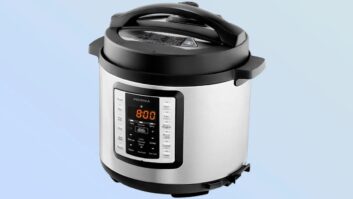Minneapolis – Best Buy’s jaw-dropping promotions over the Thanksgiving weekend contributed to weaker-than-expected earnings for the third quarter, the company said.
However, CEO Brad Anderson defended the aggressive price moves, stating they helped Best Buy win market share, brand loyalty and new customers as the chain headed into the final and most earnings-rich quarter of its fiscal year.
“We underperformed on the bottom line, but we are not disappointed in our performance,” he told analysts on a conference call. “The gross profit rate decline was larger than expected, but we made the right choice on margin. We chose to match or beat the competition on stake-in-the-ground categories including flat panel TV, and I would do it again.”
Anderson said the actions on Black Friday, which included a Toshiba notebook for $250 and an unprecedented $1,000 price point on Panasonic’s 42W-inch step-up plasma HDTV, generated record traffic and significant gains in market share. “We were willing to make a small investment in gross profit rate to secure customers,” he said. “We gained market share in flat panel TVs and notebook computers and sold a lot of gift cards that will be redeemed at twice the face value.”
The company’s gross profit rate for the third quarter was 23.5 percent of revenue, down from 24.4 percent last year, and operating income for its U.S. operations fell 6 percent to $186 million for the three-month period, which included the first three days of the Thanksgiving holiday.
Company-wide revenue rose 16 percent to $8.5 billion and same store sales grew 4.8 percent compared to a 3.3 percent gain last year. Domestically, net sales rose 11 percent to $7.2 billion and comp store sales increased 3.6 percent, compared to a 3.3 percent gain last year.
Broken out by channel, same store sales at U.S. Best Buy locations increased 3.7 percent during the quarter, while same store sales at the 20-unit Magnolia Audio Video chain fell 10 percent on total revenue of $41 million, due to TV price compression and tough year-ago comparisons. Online sales rose over 30 percent for the period thanks to improvements in the company’s Web sites and in-store pick-up process, while Pacific Sales, the recently acquired 14-store luxury white goods chain, generated $77 million in net sales.
Total revenue was boosted by the addition of 41 new Best Buy locations, 131 Five Star white- and brown-goods stores in China, and the Pacific Sales chain. Comparable store sales were driven by a 13.7 percent increase in Canadian store comps, plus increases in average transaction size as the company’s revenue mix continued to shift toward higher-ticket items.
Despite the margin hit on Black Friday, which executives more accurately referred to as “Red Friday,” Best Buy had the busiest shopping day in its history, with about 3 million customers visiting its flagship stores. Of those, said president Brian Dunn, 1.5 million were among the chain’s most profitable customers; 270,000 were new customers; and 250,000 were members of Best Buy’s Reward Zone loyalty program.
Anderson acknowledged that engaging in the post-Thanksgiving promotions “made no economic sense,” but determined from a customer-centric perspective that “losing the weekend would have an elongated impact.” To ensure a positive experience for its early-bird shoppers, the company prepared for Black Friday by investing in its store personnel and infrastructure, said executive VP Tim McGeehan. Measures included increased incentives and vendor training for sales associates; supply chain improvements that resulted in Black Friday in-stocks of 99 percent; and posting holiday circulars online and improving in the site’s search engine.
Also easing the early morning crush was the use of store maps, color-coded balloons, on-time openings and product tickets that guaranteed a purchase for those waiting in line, plus an e-commerce site that held up to quadruple spikes in traffic. “Customers said it made it worth camping out,” McGeehan said.
Dunn, who visited the Eden Prairie, Minn. headquarters store at 4:30 a.m. along with 2,000 customers, said that instead of pandemonium, “the shelves were stacked, the store looked great, the checkout line moved with amazing speed and the execution hummed,” in a scenario that was repeated across the country.
As a result, noted CFO Darren Jackson, comparable store sales grew by the double digits Thanksgiving weekend, on top of last year’s double digit gain. Despite the earnings “speed bump,” which was caused in part by “a more intense promotional environment in home theater and notebook computers than last year, CE is the focus on the holidays,” he said, “and we had to respond to steep promotions because of the name that’s over our doors.”
On the product front, flat panel TVs experienced a “very strong” double-digit comp store sales gain for the quarter due to higher unit volume as prices declined; improved assortment in larger screen sizes; and the addition of 136 more Magnolia Home Theater shops and 89 remodeled TV departments, the company said. At the same time, comp sales of direct view and rear projection TVs declined.
Comp sales for the home office category were flat, with double-digit gains in notebook sales, and added lift from Geek Squad services, offset by low double-digit declines in desktop computers.
Video gaming saw a “solid double-digit” gain on strong sales of new (PlaySation 3 and Wii) and existing platforms, but was partially offset by declines in CD and DVD sales.
Comps declined 4.6 percent in major appliances amid industry-wide weakness, although increases in average selling prices (ASPs) helped boost majaps to 8 percent of Best Buy’s revenue mix, up from 6 percent last year. Best Buy believes its white good market share increased in the third quarter.
Gift card sales enjoyed double digit gains during the period and Jackson projected 15 percent to 16 percent growth for the category for the full fiscal year.
Mike Vitelli, Best Buy’s senior VP for CE and product management, said flat panel ASPs had fallen “lower than we planned,” with LCD down 25 percent and plasma down 30 percent year-over-year. But prices are set for the fourth quarter, he said, and the rate of decline is expected to slow in 2007, based on conversations with manufacturers.
Despite the price compression, the future looks bright for flat panel and Best Buy, Vitelli said. Household penetration in advanced TVs is only 25 percent, he noted, and the company is well-positioned to up-sell the whole basket of audio, accessory, source and service attachments to compliment the TV purchase.
No. 2 CE specialty chain Circuit City reports its results next on Dec. 19.












